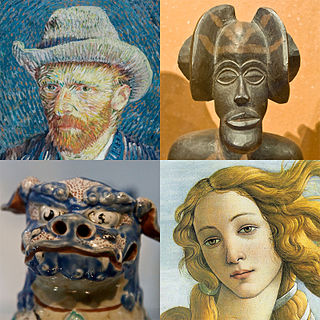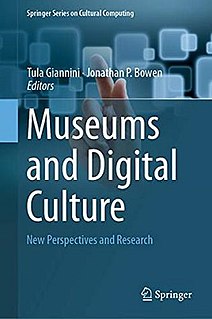Related Research Articles

Art is a diverse range of human activity, and resulting product, that involves creative or imaginative talent expressive of technical proficiency, beauty, emotional power, or conceptual ideas.

Aesthetics, or esthetics, is a branch of philosophy that deals with the nature of beauty and taste, as well as the philosophy of art. It examines aesthetic values, often expressed through judgments of taste.

Interdisciplinarity or interdisciplinary studies involves the combination of two or more academic disciplines into one activity. It draws knowledge from several other fields like sociology, anthropology, psychology, economics, etc. It is about creating something by thinking across boundaries. It is related to an interdiscipline or an interdisciplinary field, which is an organizational unit that crosses traditional boundaries between academic disciplines or schools of thought, as new needs and professions emerge. Large engineering teams are usually interdisciplinary, as a power station or mobile phone or other project requires the melding of several specialties. However, the term "interdisciplinary" is sometimes confined to academic settings.
Information art, which is also known as informatism or data art, is an emerging art form that is inspired by and principally incorporates data, computer science, information technology, artificial intelligence, and related data-driven fields. The information revolution has resulted in over-abundant data that are critical in a wide range of areas, from the Internet to healthcare systems. Related to conceptual art, electronic art and new media art, informatism considers this new technological, economical, and cultural paradigm shift, such that artworks may provide social commentaries, synthesize multiple disciplines, and develop new aesthetics. Realization of information art often take, although not necessarily, interdisciplinary and multidisciplinary approaches incorporating visual, audio, data analysis, performance, and others. Furthermore, physical and virtual installations involving informatism often provide human-computer interaction that generate artistic contents based on the processing of large amounts of data.
Sound art is an artistic activity in which sound is utilized as a primary medium or material. Like many genres of contemporary art, sound art may be interdisciplinary in nature, or be used in hybrid forms. According to Brandon LaBelle, sound art as a practice "harnesses, describes, analyzes, performs, and interrogates the condition of sound and the process by which it operates."

Jonathan P. Bowen FBCS FRSA is a British computer scientist and an Emeritus Professor at London South Bank University, where he headed the Centre for Applied Formal Methods. Prof. Bowen is also the Chairman of Museophile Limited and has been a Professor of Computer Science at Birmingham City University, Visiting Professor at the Pratt Institute, University of Westminster and King's College London, and a visiting academic at University College London.

Johanna Drucker is an American author, book artist, visual theorist, and cultural critic. Her scholarly writing documents and critiques visual language: letterforms, typography, visual poetry, art, and lately, digital art aesthetics. She is currently the Martin and Bernard Breslauer Professor in the Department of Information Studies at the Graduate School of Education and Information Studies at UCLA.
Canadian artist-run centres are galleries and art spaces developed by artists in Canada since the 1960s. Artist-run centre is the common term of use for artist-initiated and managed organizations in Canada. Most centres follow the not-for-profit arts organization model, do not charge admission fees, pay artists for their contributions are non-commercial and de-emphasize the selling of artwork.

Mel Alexenberg is an American-Israeli artist, art educator, and writer recognized for his pioneering work exploring the intersections of art, science, technology and digital culture. He is known as Grandfather of NFTs since his experimental digital artworks span more than half a century. He created the first digital computer generated painting in 1965, experimental digital fine art prints in the 1980s that are in 30 museum collections worldwide, circumglobal cyberangel flights honoring Rembrandt in 1989 and in 2019, and a dialogue between tactile artworks and NFTs. Alexenberg has educated generations of young artists as professor at Columbia University and universities in Israel, research fellow at MIT Center for Advanced Visual Studies, and head of the art department at Pratt Institute where he taught the first course on creating art with computers.
Sustainable art is art in harmony with the key principles of sustainability, which include ecology, social justice, non-violence and grassroots democracy. Sustainable art may also be understood as art that is produced with consideration for the wider impact of the work and its reception in relationship to its environments.
Systematic musicology is an umbrella term, used mainly in Central Europe, for several subdisciplines and paradigms of musicology. "Systematic musicology has traditionally been conceived of as an interdisciplinary science, whose aim it is to explore the foundations of music from different points of view, such as acoustics, physiology, psychology, anthropology, music theory, sociology, and aesthetics." The most important subdisciplines today are music psychology, sociomusicology, philosophy of music, music acoustics, cognitive neuroscience of music, and the computer sciences of music. These subdisciplines and paradigms tend to address questions about music in general, rather than specific manifestations of music. In the Springer Handbook of Systematic Musicology "(the) sections follow the main topics in the field, Musical Acoustics, Signal Processing, Music Psychology, Psychophysics/Psychoacoustics and Music Ethnology while also taking recent research trends into consideration, like Embodied Music Cognition and Media Applications. Other topics, like Music Theory or Philosophy of Music are incorporated in the respective sections."

New media art includes artworks designed and produced by means of electronic media technologies, comprising virtual art, computer graphics, computer animation, digital art, interactive art, sound art, Internet art, video games, robotics, 3D printing, and cyborg art. The term defines itself by the thereby created artwork, which differentiates itself from that deriving from conventional visual arts. New Media art has origins in the worlds of science, art, and performance. Some common themes found in new media art include databases, political and social activism, Afrofuturism, feminism, and identity, a ubiquitous theme found throughout is the incorporation of new technology into the work. The emphasis on medium is a defining feature of much contemporary art and many art schools and major universities now offer majors in "New Genres" or "New Media" and a growing number of graduate programs have emerged internationally. New media art may involve degrees of interaction between artwork and observer or between the artist and the public, as is the case in performance art. Yet, as several theorists and curators have noted, such forms of interaction, social exchange, participation, and transformation do not distinguish new media art but rather serve as a common ground that has parallels in other strands of contemporary art practice. Such insights emphasize the forms of cultural practice that arise concurrently with emerging technological platforms, and question the focus on technological media per se. New Media art involves complex curation and preservation practices that make collecting, installing, and exhibiting the works harder than most other mediums. Many cultural centers and museums have been established to cater to the advanced needs of new media art.
The following outline is provided as an overview of and topical guide to the humanities:
Marlena Novak is an American artist based in Chicago and Amsterdam.
Patrick Lichty is a conceptual media artist, activist, curator, and educator. Lichty is currently a Creative Digital Media professor at Winona State University.

Andy Lomas is a British artist with a mathematical background, formerly a television and film CG supervisor and more recently a contemporary digital artist, with a special interest in morphogenesis using mathematical morphology.

Laura Wright is a professor of English at Western Carolina University. Wright proposed vegan studies as a new academic field, and her book The Vegan Studies Project: Food, Animals, and Gender in the Age of Terror (2015) served as the foundational text of the discipline. As of 2021 she had edited two collections of articles about vegan studies.
Art-based research is a mode of formal qualitative inquiry that uses artistic processes in order to understand and articulate the subjectivity of human experience.

Museums and Digital Culture (2019), edited by Tula Giannini and Jonathan P. Bowen, who are also the authors of 12 chapters, is an interdisciplinary book about developments in digital culture with respect to museums.
Prof. Tula Giannini is an American academic with subject expertise in musicology, digital culture, and digital heritage.
References
- ↑ Augsburg, Tanya (2017). "Interdisclinary Arts". In Frodeman, Robert; Klein, Julie Thompson; Pacheco, Roberto C. S. (eds.). The Oxford Handbook of Interdisciplinarity. Oxford Handbooks (2nd ed.). Oxford University Press. doi:10.1093/oxfordhb/9780198733522.013.12. ISBN 978-0198733522.
- ↑ "What is Interdisciplinary Arts?". www.eckerd.edu. Eckerd College . Retrieved 13 October 2020.
- ↑ "What Does the Term Interdisciplinary Artist Imply?". www.widewalls.ch. Widewalls. Retrieved 13 October 2020.
- ↑ Giannini, Tula; Bowen, Jonathan P., eds. (2019). "Part VI: Digital Artists". Museums and Digital Culture: New Perspectives and Research . Series on Cultural Computing. Springer. pp. 351–414. doi:10.1007/978-3-319-97457-6. ISBN 978-3-319-97456-9. ISSN 2195-9064. S2CID 146115899.